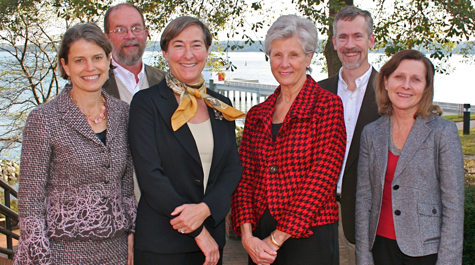Garden Club members explore marine issues at VIMS
Members of the Garden Club of Virginia visited the Virginia Institute of Marine Science and the College of William and Mary on November 5 as part of their statewide conservation forum, “Beneath the Surface.”
Speakers at the 52nd-annual event, including VIMS professors Elizabeth Canuel, Emmett Duffy, and Carl Hershner, explored science-based solutions that can help society—gardeners in particular—minimize human impacts on the Commonwealth’s marine resources.
The Garden Club of Virginia comprises 47 local clubs with more than 3,300 members around the Commonwealth. The Club’s goals are to celebrate the beauty of the land, conserve the gifts of nature, and challenge future generations to build on this heritage.
Forum Co-Chair Marilyn South, of the Middle Peninsula Garden Club, says the focus of this year’s event on marine issues reflects a growing recognition that home and garden activities within the Chesapeake Bay watershed have a direct impact on coastal water quality.
The Forum began with a morning keynote address by Dr. Sandra Whitehouse, a senior advisor at the Ocean Conservancy in Washington D.C. Whitehouse, who pursued graduate studies in the School of Marine Science at VIMS from 1981 to 1986 and earned a Ph. D. from the University of Rhode Island in 1994, focused on marine spatial planning. This growing field applies principles of urban planning and smart growth to the ocean, in an attempt to maximize sustainable use of coastal and open-ocean resources while minimizing habitat loss and potential conflicts among resource users.
At VIMS, Garden Club members enjoyed afternoon presentations by professors Elizabeth Canuel, Emmett Duffy, and Carl Hershner.
Canuel and Duffy described their on-going efforts to turn nutrient pollution into fuel as part of the Chesapeake Algae Project, or ChAP. Duffy provided background on the project, which aims to use wild strains of algae to filter nitrogen and other pollutants from Bay waters, and to then harvest those algae for their bodily oils, which can be transformed into “biofuels” for use in transportation. Canuel discussed collaborative efforts to determine the combinations of algal strains and environmental conditions that will maximize biofuel production.
Hershner, Director of the Center for Coastal Resources Management at VIMS, described the benefits of “living shorelines” in providing an effective means of managing shoreline erosion while providing habitat for marine plants and animals. He also discussed the scientific rationale for the “pollution diet” currently being proposed for Bay waters by the U.S. Environmental Protection Agency. Hershner will further explore these “total daily maximum loads” during VIMS’ monthly After Hours lecture series in January.



